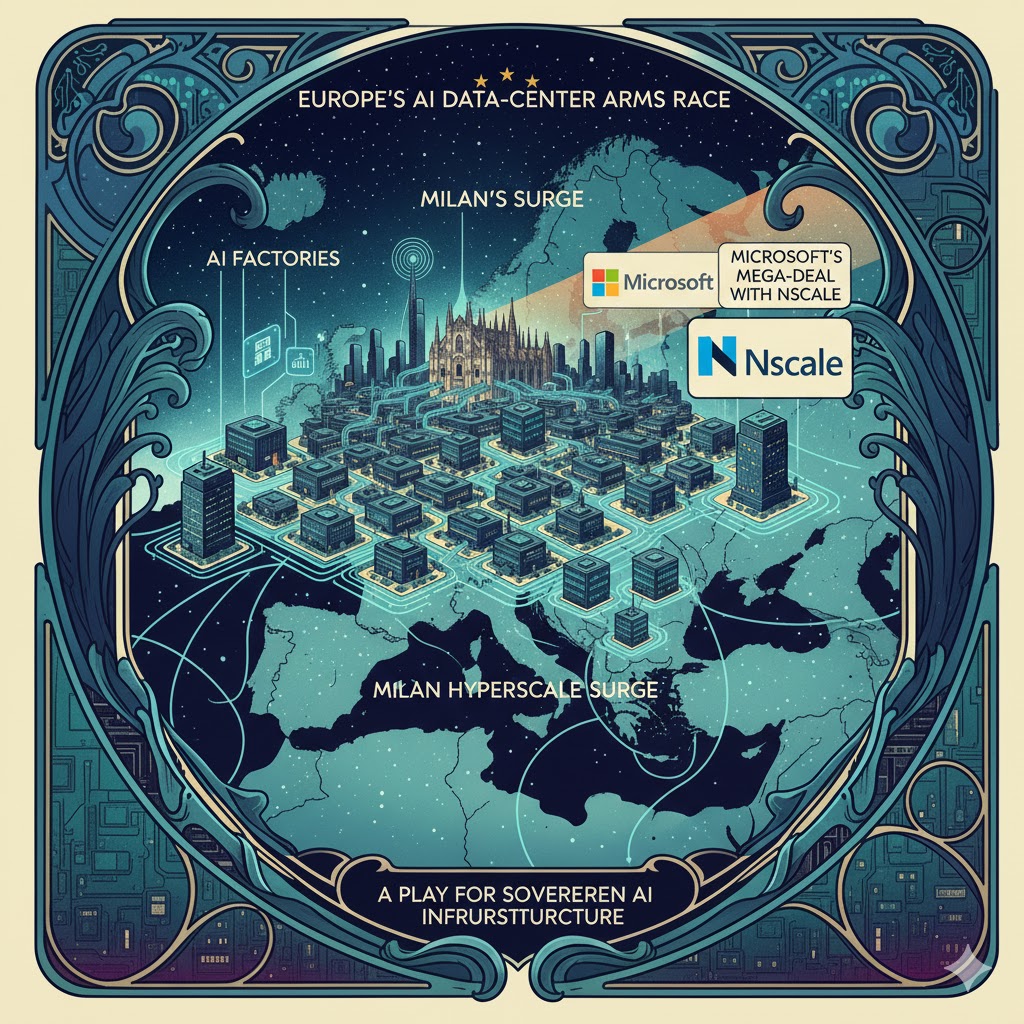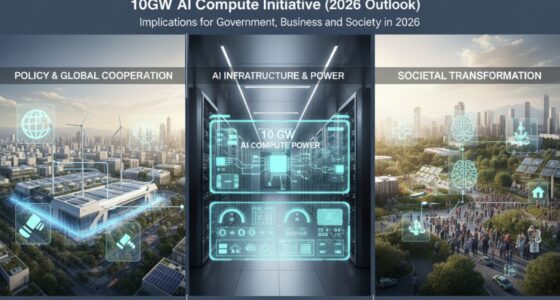Introduction
Artificial‑intelligence (AI) training has become one of the most energy‑intensive activities on the planet. The next generation of AI models rely on enormous clusters of graphics‑processing units (GPUs), which in turn require purpose‑built data centres and reliable, high‑capacity power supplies. Recent announcements in Europe point to two complementary trends: the rapid build‑out of data‑centre capacity in northern Italy and a transatlantic hardware deal between Microsoft and British AI‑infrastructure firm Nscale. Together they illustrate how AI is reshaping the geography of computing, the electric‑power industry and capital flows.

Milan and Lombardy: Europe’s new AI build‑out
A ten‑fold increase in capacity
Italy’s Lombardy region, home to the financial capital Milan, is emerging as one of Europe’s newest hyperscale corridors. A2A chief executive Renato Mazzoncini said the province around Milan currently hosts roughly 200 MW of installed data‑centre capacity but is on track to add around 2 GW over the next five years – a ten‑fold increasereuters.com. The region’s existing peak electricity demand is about 1.5 GW, so meeting AI’s appetite will require heavy investment in both generation and transmissionreuters.com.
To avoid overloading local distribution networks, the planned data centres will connect directly to Italy’s high‑voltage grid or even link to power plantsreuters.com. Mazzoncini noted that more than 3 GW of thermoelectric capacity (mostly gas‑fired combined‑cycle units) is already built, under construction or authorised in the region to support the new demandreuters.com. Although Italy faces higher electricity prices than some northern European markets, he argued that the cost of renewable energy is converging across Europe and that operators can secure long‑term power deals to hedge price riskreuters.com.
Incoming operators: Vantage and Echelon
Global developers are lining up for a slice of Milan’s growth story. Vantage Data Centers, a U.S.‑based firm backed by DigitalBridge, announced in October that it will invest €350 million to build a second campus in Italy, consisting of two facilities with a combined 32 MW of IT capacityreuters.com. The first phase is scheduled to come online in spring 2026, and Italy’s government has recognised Vantage’s multi‑campus development as strategic national infrastructure, paving the way for a total €4 billion investment and up to 4 000 construction jobs over eight yearsreuters.com.
Echelon Data Centres, an Irish developer, has partnered with Starwood Capital to acquire a 37‑acre site near Treviglio, about 30 km east of Milan. The €3 billion LIN10 campus will tap an existing substation capable of 250 MW of gross power, of which 100 MW is available immediatelydatacenterdynamics.com. Echelon plans to reuse an existing industrial building to deliver 72 MW of IT capacity quickly and then add a second, 120 MW facilitydatacenterdynamics.com. The site will incorporate on‑site solar panels and generators running on hydrotreated vegetable oil (HVO) rather than diesel, and the company expects operations to start in 18–24 monthsdatacenterdynamics.com. Chief executive Niall Molloy called the project “one of the most attractive in Europe” and said it forms part of a pipeline of 1.5 GW that Echelon plans to deliver over the next five yearsdatacenterdynamics.com.
Heat recovery and wider investment signals
Utilities are also exploring ways to capture the waste heat from AI compute. In Brescia, A2A and French firm Qarnot inaugurated a liquid‑cooled data centre that channels heat into the local district‑heating network. A2A estimates the pilot plant will heat more than 1 350 apartments and cut carbon emissions by 3 500 tonnes annuallyreuters.com. The company believes similar projects across Lombardy could eventually heat 150 000 apartmentsreuters.com.
This surge of interest is mirrored in Italy’s grid statistics. Connection requests to the national high‑voltage network managed by Terna jumped to 42 GW by March 2025, up from 30 GW at the end of the previous yearreuters.com. Researchers at Milan’s Polytechnic University project that data‑centre investments will double to €10 billion in the 2025‑26 periodreuters.com. Across Europe, an Ember think‑tank report warns that grid bottlenecks in established hubs such as Frankfurt, London, Amsterdam and Dublin could push new investments toward markets with faster connection times. Legacy hubs often take 7–10 years to secure grid access, whereas Italy can connect a new data centre in about three yearsreuters.com. Italy’s relative agility could therefore attract developers away from congested northern markets.
Europe’s electric‑grid challenge
The scramble to build AI infrastructure is colliding with Europe’s sluggish grid‑expansion plans. Ember estimates that by 2035 half of Europe’s data‑centre capacity could relocate outside today’s dominant hubsreuters.com. Sweden, Norway and Denmark expect electricity demand from data centres to triple by 2030, while Austria, Greece, Finland, Hungary, Italy, Portugal and Slovakia could see consumption rise three‑to‑five‑fold by 2035reuters.com. These projections underscore a simple truth: AI hardware will go wherever power and grid connections are plentiful.
Italy’s willingness to integrate data centres directly into the high‑voltage grid and to build combined‑cycle plants specifically for AI loads highlights a pragmatic approach that contrasts with the grid‑constraint anxieties in other parts of Europe. At the same time, the push for heat recovery and HVO‑powered backup systems signals an effort to counter criticism that AI computing is incompatible with decarbonisation.
Microsoft and Nscale: A four‑country GPU megadeal
While Italy prepares to host dozens of new megawatts, Microsoft is securing the hardware that will fill those buildings. On 15 October Microsoft and London‑based Nscale announced a contract for around 200 000 Nvidia GB300 GPUs – one of the largest AI‑infrastructure deals to date. According to Reuters, the contract could generate up to $14 billion in revenue for Nscalereuters.com and will be executed in collaboration with Dell Technologiesreuters.com.
The agreement spans four sites across two continents. Nscale’s press release says about 104 000 GPUs will be deployed at a ~240 MW hyperscale AI campus in Texas, leased from Ionic Digital; Microsoft holds an option to expand the site to 1.2 GWnscale.com. In Portugal, 12 600 GPUs will be installed from Q1 2026 at the Start Campus in Sinesnscale.com, providing customers in the European Union with sovereign AI solutions. The companies previously announced a plan to build the UK’s largest AI supercomputer at Nscale’s Loughton campus outside London; the 50 MW facility, scalable to 90 MW, will house about 23 000 GPUs from Q1 2027nscale.com. Additionally, Nscale’s joint venture with Aker will supply around 52 000 GPUs to Microsoft from a hyperscale campus in Narvik, Norwaynscale.com.
Nscale, founded in 2024, has expanded rapidly. In September the company raised $1.1 billion from investors including Norway’s Aker and Finland’s Nokia to accelerate its data‑centre build‑outreuters.com. Reuters reported that Aker’s 9.3 % stake could rise to 12.2 % if certain earn‑out conditions are met, and that several US and European tech investors participated in the fundingreuters.com. The company is reportedly considering an IPO in 2026. Citigroup analysts estimate that global AI‑infrastructure spending will exceed $2.8 trillion through 2029reuters.com, and Microsoft’s partnership with Nscale positions both companies to capture a significant share of that demand.
Implications
The developments in Lombardy and Nscale’s international deal underscore two sides of the same story. Power availability and grid access are becoming as important as fibre connectivity when choosing data‑centre sites. Italy’s combination of fast grid hook‑ups, abundant natural‑gas plants and supportive local authorities is luring hyperscale developers away from Europe’s traditional hubs. Meanwhile, hyperscalers like Microsoft are securing GPU supply chains years in advance and partnering with vertically integrated providers such as Nscale to scale up quickly.
These trends also raise broader questions. Can Europe decarbonise its power sector while adding gigawatts of new data‑centre load? Will heat‑recovery schemes and the use of HVO or other low‑carbon fuels mitigate the environmental impact? And as AI models grow ever larger, will energy‑intensive computing shift towards regions with cheap renewable power, such as the Nordics or North Africa?
For now, the evidence suggests a race between power infrastructure and AI innovation. Lombardy’s impending 2 GW build‑out and Microsoft’s 200 000‑GPU purchase show that the AI boom is not a distant prospect: it is already reshaping Europe’s energy landscape and spurring some of the largest industrial investments seen in decades.









